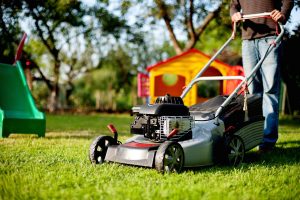 Renting a property with a garden can be very rewarding and doesn’t have to mean a lot of work if you keep on top of things. A tenant’s responsibility to lawns and gardens does not just stop at watering – regular maintenance needs to be carried out. By making few changes to your daily or weekly routine and dedicating a little bit of time to your garden especially at the beginning of Summer to prepare for the hotter months, it can not only extend the life of your lawns and gardens, but make them a little more resilient and keep your gardens and lawns looking healthy throughout the year. This will mean less time weeding and more time for yourself!
Renting a property with a garden can be very rewarding and doesn’t have to mean a lot of work if you keep on top of things. A tenant’s responsibility to lawns and gardens does not just stop at watering – regular maintenance needs to be carried out. By making few changes to your daily or weekly routine and dedicating a little bit of time to your garden especially at the beginning of Summer to prepare for the hotter months, it can not only extend the life of your lawns and gardens, but make them a little more resilient and keep your gardens and lawns looking healthy throughout the year. This will mean less time weeding and more time for yourself!
Tools to get you started
Every gardener needs the right instruments to help you work smarter and not harder. These can be purchased quite easily from your local hardware store or perhaps borrowed from a neighbour or friend. Different tools assist with different gardening tasks so it’s best to work out what you need before you start. To find out more about different gardening tools click the below link;
Watering & Reticulation
Ensuring that your reticulation is working properly and that sprinkler fittings are tested & replaced if damaged will get the season off to a good start. Please note it is condition of your tenancy agreement to replace any broken or clear any blocked sprinkler heads. Sprinkler heads are a consumable item, much like light globes, and require replacing and maintenance throughout your tenancy.
Keep in mind also that even though you have scheduled watering days for your automatic sprinkler systems, you are allowed to hand water, as many additional times required to keep your lawns green and healthy. Only being allowed to water 2 days per week, is not an excuse for dead or dry gardens. Watering in the early morning or late evening is best as this will help keep your gardens and lawns from drying out or burning in the intense heat during the day.
To find out your regular sprinkler watering days click the link to water corp:
Water Corporation – Watering Days
Run your sprinklers through their cycle for 1-2 minutes on each station and check that the sprinkler heads are popping up & spraying correctly. Check pressure level consistency and look for pooling areas of water which may indicate a water leak in the piping. If any sprinkler heads need replacing the easiest way is to do this is take an example with you (or a pic of the specific sprinkler head that you need) to your local hardware store and purchase replacements. You can also usually get fantastic advice from them should you need any more information or there are many helpful videos on the internet, such as below:
How to flush & replace pop up sprinkler nozzles
Mulch & Soil Wetter
Mulch works much like a blanket, evaporation is reduced as it holds moisture in the soil for much longer. If your soil is bare, or the mulch is looking thin, spread a fresh layer to a depth of 7–10cm straight after a deep soaking. Wood chips are the best type of mulch as they allow water to flow through but prevent evaporation. Mulch will also help keep the weeds at bay!
Using a soil wetting agent on gardens, lawns, potting mixes and mulches improves the infiltration of water so it can reach further down to the root system. More effective water saturation means you won’t need to water quite as often; saving water, time and money.
Fertiliser & Liquid Seaweed
Water isn’t the only thing your lawn will need. Using an appropriate fertiliser solution or granules will support growth of grass blades and root systems. Liquid Seaweed (eg Seasol) is organic and sustainable and provides a vast array of nutrients that can benefit all kinds of plant life. Ensure you read the instructions carefully as some will need to be watered in straight after application, are slow release or some may be concentrated and need to be distributed via your watering hose.
Weeds in Pavers
Weeds tend to pop up anywhere including between the paving or along the driveway of your property. Instead of letting them take over your pavers, you can help prevent this from occurring (or treat any new shoots) by spraying the joins of the paving.
There are several products you can purchase from a hardware store, however if you prefer the more organic route – there are a couple of other options such as using boiling water (carefully) or vinegar in a spray bottle instead. If you chose to use a chemical spray, always read (and follow) the safety and application instructions outlined by the manufacturer. Safety equipment and follow-up applications may be required. Check that there is clear weather for at least 2-3 days to follow to ensure the treatment does not get washed away.
Lawn Maintenance
If your lawn is looking like it needs a bit of a haircut, before you start that mower make a plan of what you need to do. Checking your equipment is all working properly, and trimming trees back to edge of garden beds or fence line to ensure they will not be an obstruction when mowing. Trim any surrounding hedging and trim/ whipper snip lawn edges first as this will make the mowing process easier.
- Clean up the lawn area before starting. Remove any toys, play equipment, dog poo, foliage debris, twigs etc
- Only cut dry lawn – this will ensure it is even and doesn’t clog up your mower. If you intend on using the grass cuttings as mulch – dry mulch is better and easier to distribute.
- Mow at the right time. Cooler parts of the day are best early morning and early evening (just make sure you are within your local council noise time limits).
- Don’t cut too short in Summer or leave too long. Don’t remove more than a third of the leaf blade to encourage dense, healthy growth – 3cm is optimal.
- Manage the weeds – use a hand held weeding tool to remove weeds such as bindis, clover, dandelions and thistles.
- Feed your lawn – water and fertilise regularly. Obtain a sprinkler for your hose if needed.
- If you are re-establishing dry or patchy lawn areas, after fertilising & using a wetasoil, mowing weekly will encourage vigorous growth – especially in Summer.
- For established lawns schedule to mow your lawn every 1-3 weeks in Summer and 4-6 weeks in Winter (depending on how dry or wet the season is)
When you put in the time and effort to support your garden’s needs, in turn you will be rewarded not only with beautiful surroundings, but there are many proven health benefits. Good exercise improving hand dexterity and heart health, reduced stress, good for self-esteem bringing a sense of accomplishment, can assist in better sleep, immune regulation and overall positive mental health.

